Here in the southern hemisphere, spring has arrived even if with minimal rain. The little rain that has fallen is nothing like “normal” spring rains (remember normal?) and nowhere near enough; we have we had about 10 mls of rain over the past week. Even so the frogs are very vocal in their celebrations.
It only seems a short time ago I was seeing northern bloggers celebrating spring, but the cycle of the seasons has moved apace. Despite the dryness here spring buds have been swelling and some blossoms are already evident.
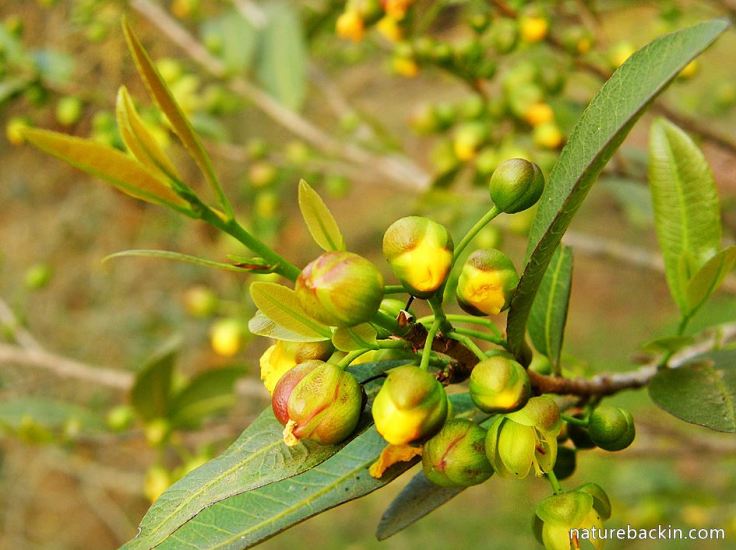
The buds of the Ochna shrub are once again starting to burst
These photos were taken last year when the buds and flowers were about twice the size they are this year. Not only are the flowers smaller this year, but many have shrivelled and dried up before the petals fully emerged from the bud – the combined effect of the prolonged dryness and the exceptionally high temperatures we had last week – with one day being 42 degrees C.
However, in a “normal” year the petals really do burst out from the bud.

Four photos showing flowers in various stages from when the petals first start protruding from the bud through to when all the petals are unfolding
I have tried to work out if this plant in our garden is the Ochna natalitia (Showy Ochna/Natal Plane) or the Ochna serrulata (Carnaval Ochna/Small-leaf Plane) but I keep changing my mind! Any guidance as to which it is would be most appreciated.
Most of the Ochna Family are shrubby or small trees. Indigenous to South Africa, the Ochna serrulata, has been introduced to other parts of the world as an ornamental garden plant, but it has become invasive in New Zealand and parts of Australia.
Plants in the Ochna family are used in traditional medicine, and several species have been shown to have antibacterial properties.
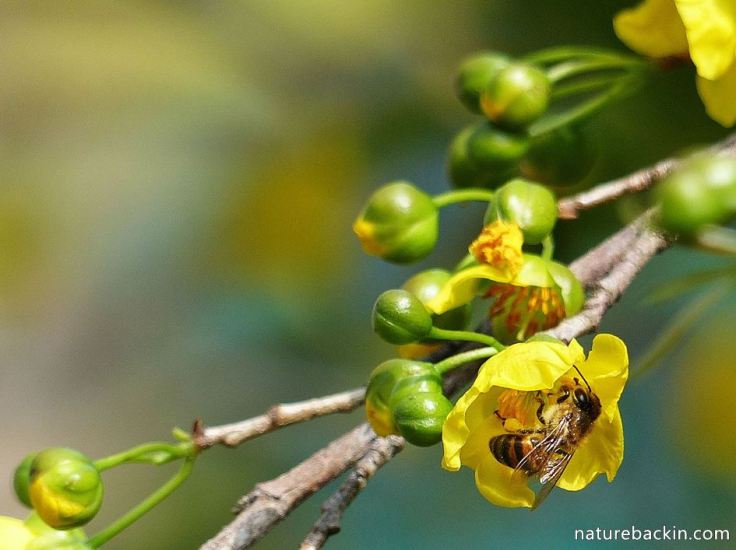
The pollen-rich flowers are attractive to honeybees
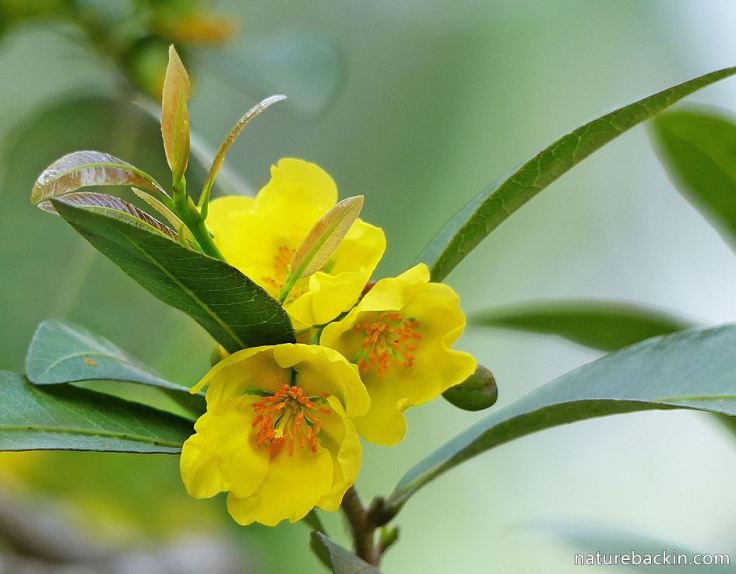
Attractively shiny new leaves add to this plant’s springtime appeal
The small and compact nature of both Ochna natalitia and Ochna serrulata make them suitable for small gardens. In addition to the lovely flowers and attractive leaves, the plants retain the calyx which turns red as the fruit forms, making this phase in late summer almost as showy as the flowers.

The ripe black fruit are eaten by birds, helping with seed dispersal. The Ochna natalitia is sometimes called the Mickey Mouse Bush (and to add to the confusion sometimes Ochna serrulata is too!), as the red calyx together with the fruit is thought to resemble Mickey Mouse – I can’t see the resemblance though. The variable number of fruits in each seed head on our plant makes me tend towards identifying the plant as the O. natalitia
I leave the Ochna in our garden to self-seed and while they are still small I dig up the seedlings and put them in pots to give away or to transplant elsewhere in the garden once they are big enough. So far none of those planted out in our garden have flowered yet.
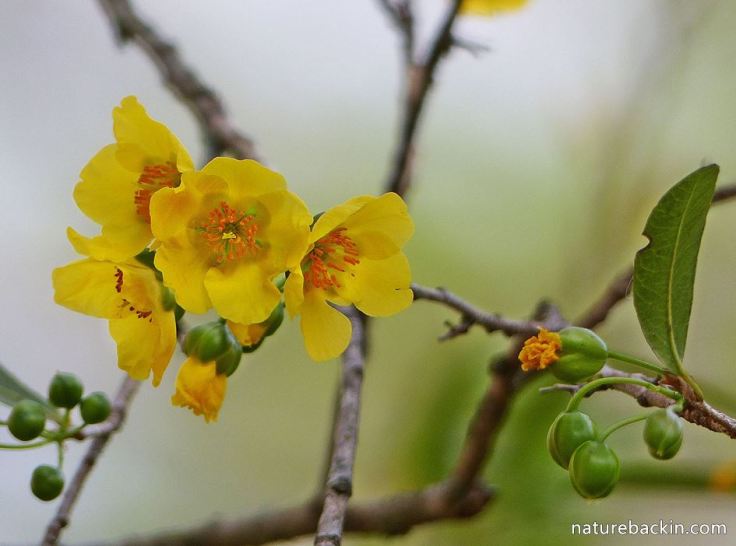
The plant flowers throughout spring. Perhaps it is the rich yellow colour or the sheer profusion of flowers that makes it one of the most cheering of plants
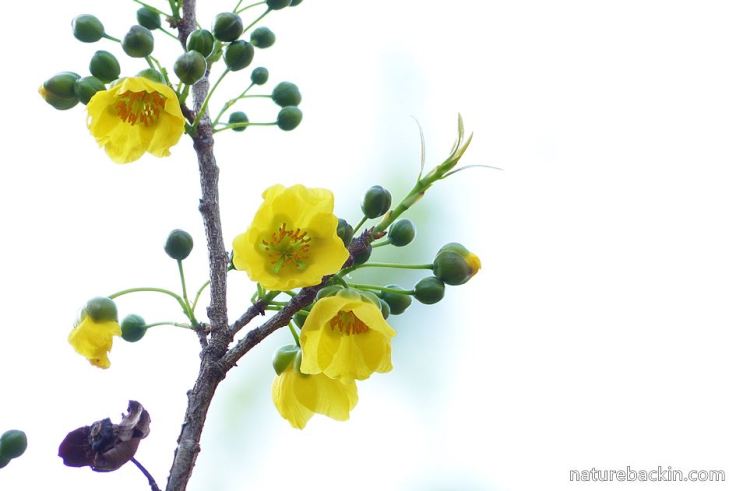
Coincidentally, writing about spring this evening is accompanied by our first storm of the season. Granted it is only a small storm with a little lightning and thunder, but now there is a steady rain drumming on the roof. Not much rain is forecast but every drop is most welcome.
Sources:
Mothogoane, M. & Rampho, E. 2009. Ochna. South African National Biodiversity Institute (SANBI). http://pza.sanbi.org/ochna; Pooley, Elsa. 1997. The Complete Field Guide to Trees of Natal, Zululand and Transkei. Durban: Natal Flora Publications Trust
Posted by Carol

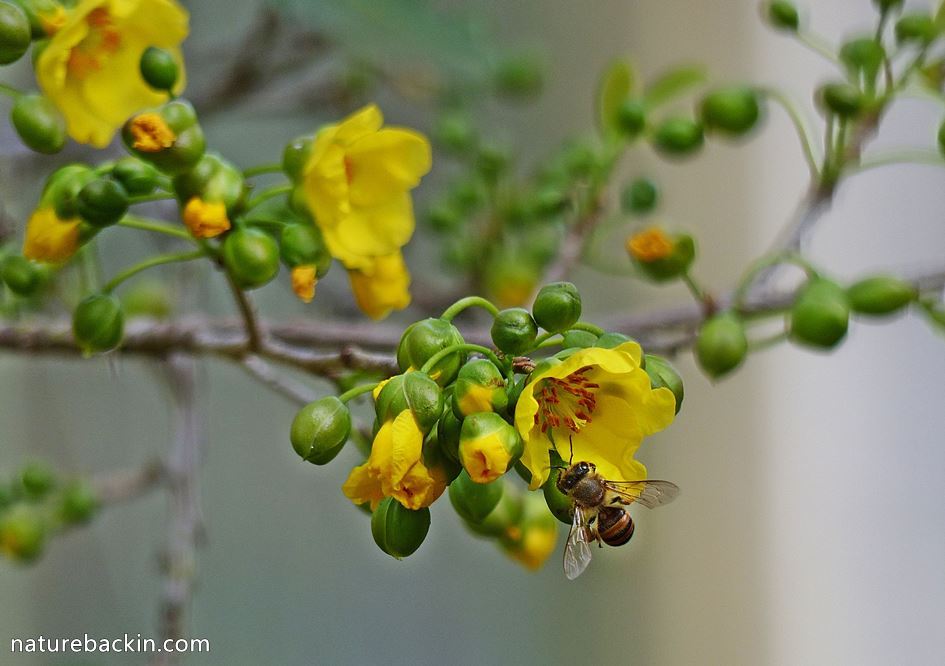







September 28, 2017 at 10:15 pm
Such beautiful photographs! Tom and I will be heading back over to NZ for the southern hemisphere this weekend. Your post is making me excited for Spring & Summer!
LikeLiked by 1 person
September 29, 2017 at 4:28 am
Thanks so much and hope you both have a great trip to NZ and enjoy the spring and the summer there.
LikeLiked by 1 person
September 29, 2017 at 5:18 am
You’re welcome! And, thank you 😊. We shall! Hopefully we’ll write a few southern hemisphere blog post whilst we’re back,
too. 😃
LikeLiked by 1 person
September 29, 2017 at 5:31 am
Am looking forward to your southern hemisphere posts!
LikeLiked by 1 person
September 22, 2017 at 8:57 am
Your photographs make me drool, your prose teaches me much. Thank you 😊
LikeLiked by 1 person
September 22, 2017 at 1:35 pm
Thanks Osyth. It is a most photogenic flower 🙂
LikeLiked by 1 person
September 22, 2017 at 1:43 pm
I need to look up what I think the European equivalent is – we had them in our garden when I was growing up but they were larger, flatter blooms. That’s the thing … your pictures are SO crisp and clear you spark my mind in all manner of ways.
LikeLiked by 1 person
September 22, 2017 at 2:08 pm
Thanks Osyth – I hope you are able to identify the flower that you remember from your childhood garden. Tantalising!
LikeLiked by 1 person
September 22, 2017 at 12:07 am
A lovely flower and your photos are superb, Carol. Glad you are getting some much needed rain.
LikeLiked by 1 person
September 22, 2017 at 1:14 pm
Thanks so much Eliza. Today, the sun has come out and dried up all the rain, but we may get a little more tomorrow …
LikeLiked by 1 person
September 21, 2017 at 9:53 pm
Spring for you and fall for us. I love these cheery yellow flowers.
LikeLiked by 1 person
September 22, 2017 at 1:13 pm
Yes they are most cheery. Enjoy the lovely colours of the trees in the fall.
LikeLiked by 1 person
September 22, 2017 at 2:44 pm
And you enjoy the spring blooms.
LikeLiked by 1 person
September 21, 2017 at 8:48 pm
O Carol, I wish I was able to give you an intelligent opinion regarding your conundrum but alas I will have to claim the 5th amendment on this one. I can confirm though that the honeybee is not related to the frisbee. Beautiful photos
LikeLiked by 1 person
September 22, 2017 at 1:11 pm
Thanks Abrie. I am trying to work out if the distinction between a honeybee and a frisbee is etymological or entomological??
LikeLike
September 23, 2017 at 6:42 pm
☺ Definitely entomological Carol. They are very similar in appearance. Basically the only difference is that the Frisbee cannot produce honey 🍯 ☺
LikeLiked by 1 person
September 24, 2017 at 5:21 am
And to think I had only noticed that both fly!
LikeLiked by 1 person
September 21, 2017 at 8:43 pm
I too am listening to a chorus of frogs in the dam across the road. Dark clouds, rumbles of thunder and some flashes of lightning brought hope this afternoon,but only a sprinkle of rain resulted – not even enough to measure. Still, the new leaves are starting to unfurl and so the hope remains. Glad you are getting some rain.
LikeLiked by 1 person
September 22, 2017 at 1:09 pm
It is so disappointing when it looks like rain and then it doesn’t come. Our storm last night ended up delivering almost nothing and it is roasting hot again today. I hope you do get some rain and soon. Awful news of the suffering in many of the farmlands with reports of several farmers committing suicide. So tragic.
LikeLike
September 21, 2017 at 8:34 pm
Beautiful representation of spring!! Tomorrow begins our autumn equinox!
LikeLiked by 1 person
September 22, 2017 at 1:03 pm
Thanks Roda. Equinox already – how incredible!
LikeLiked by 1 person
September 22, 2017 at 1:34 pm
Time moves so quickly!!
LikeLiked by 1 person
September 21, 2017 at 8:03 pm
These are wonderful images of your spring, Carol! 🙂 We are now in the autumn here, and how the seasons appear to move round so very quickly.
LikeLiked by 1 person
September 22, 2017 at 12:58 pm
Thanks Pete. And it is incredible how fast the seasons seem to go by. Enjoy the autumn changes in your neck of the woods.
LikeLiked by 1 person
September 22, 2017 at 4:02 pm
Thank you, and enjoy your spring! 🙂
LikeLiked by 1 person
September 21, 2017 at 7:53 pm
Fabulous photographs.
LikeLiked by 1 person
September 22, 2017 at 12:57 pm
Thanks very much Sherry.
LikeLike